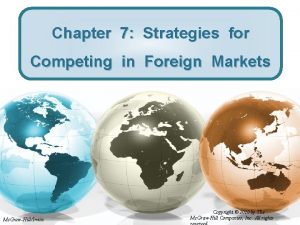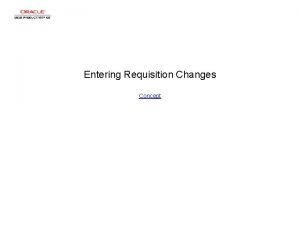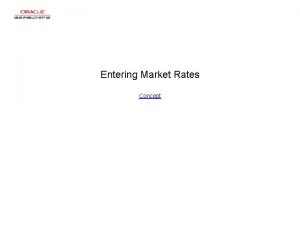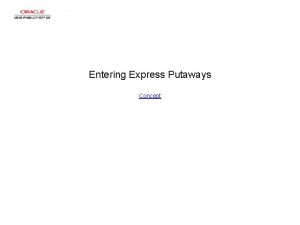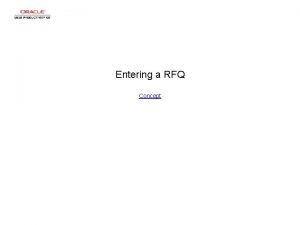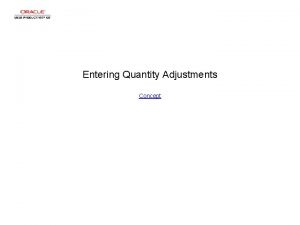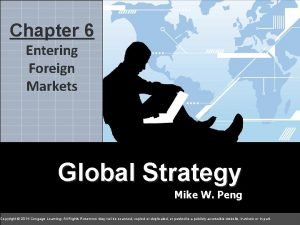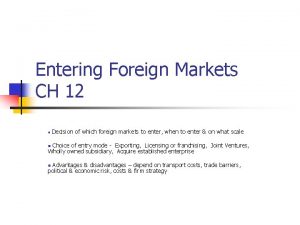Strategies for Analyzing and Entering Foreign Markets Steps























- Slides: 23


Strategies for Analyzing and Entering Foreign Markets

Steps involved in analyzing and entering foreign market �To successfully increase market share, profits and revenue, firms must follow three steps: �Assess alternative markets �Assessing or evaluating costs, benefits and risks. �Selecting the mode of entry

Steps involved in analyzing and entering foreign market 1. Assessing alternative foreign markets: In assessing alternative foreign markets, a firm must consider a variety of factors, including� Evaluating market potential � Evaluating levels of competition � Evaluating legal and political environment � Evaluating socio-cultural influences

Steps involved in analyzing and entering foreign market 2. Evaluating costs, benefits and risks: The next step in foreign market assessment is a careful evaluation of the costs, benefits and risks associated with doing business in foreign market. – Costs: There are two types of costs. Direct and Opportunity costs. – Benefits: • • Expected sales and profits from the market Lower acquisition and manufacturing costs Access to new technology The opportunity to achieve synergy with other operations etc.

Steps involved in analyzing and entering foreign market �Risks: �Exchange rate fluctuations �War �Terrorism �Government seizure of property etc.

Steps involved in analyzing and entering foreign market 3. Choosing a mode of entry: Decision Factors: §Ownership advantages §Location advantages §Internalization advantages §Other factors §Need for control §Resource availability §Global strategy Exporting International Licensing International Franchising Specialized Modes Foreign Direct Investment

Steps involved in analyzing and entering foreign market �Exporting to Foreign Markets: Exporting is the process of sending goods and services from one country to another for use or sale there. It is the most simplest mode of internationalizing a domestic business.

Exporting to Foreign Markets Advantages • Relatively low financial exposure • Permit gradual market entry • Acquire knowledge about local market • Avoid restrictions on foreign investment Disadvantages • Vulnerability to tariffs and NTBs • Logistical complexities • Potential conflicts with distributors

Forms of Exporting �Indirect exporting �Direct exporting �Intracorporate transfers

Figure 12. 2 © 2004 Prentice Hall Forms of Exporting 12 -11

International Licensing �Licensing is an agreement between two parties- licensor and licensee, by which the licensor (owner) permits the licensee( user) to use its intellectual property like- patent, trademark etc for production or distribution of goods in return of a fee or commission. LICENSOR • Leases the right to use its intellectual property • Earns new revenues with relatively low investment LICENSEE • Uses the intellectual property to create products for local sale • Pays a royalty back to the licensor

International Licensing Advantages • Low financial risks • Low-cost way to assess market potential • Avoid tariffs, NTBs, restrictions on foreign investment • Licensee provides knowledge of local markets Disadvantages • Limited market opportunities/ profits • Dependence on licensee • Potential conflicts with licensee • Possibility of creating future competitor

International Franchising �Franchising is an agreement between two parties - franchisor and franchisee by which the franchisor allows the franchisee to operate an enterprise using an intellectual property likepatent, trademark in return for a fee and keeping a reasonable amount of control in the hands of franchisor.

International Franchising Advantages • Low financial risks • Low-cost way to assess market potential • Avoid tariffs, NTBs, restrictions on foreign investment • Maintain more control than with licensing • Franchisee provides knowledge of local market Disadvantages • Limited market opportunities/ profits • Dependence on franchisee • Potential conflicts with franchisee • Possibility of creating future competitor

Specialized entry modes �Contract Manufacturing: It is used by firms, both large and small, that outsource most or all of their manufacturing needs to other companies. This strategy reduces the financial and human resources firms need to devote to the physical production of their products.

Contract Manufacturing Advantages • Low financial risks • Minimize resources devoted to manufacturing • Focus firm’s resources on other elements of the value chain Disadvantages • Reduced control (may affect quality, delivery schedules, etc. ) • Reduce learning potential • Potential public relations problems

Management Contract �It is a contract based on which firms in one country render management expertise to the firms of another. �It is an arrangement in which one company provides personnel to perform general or specialized management function for another.

Management Contract Disadvantages Advantages • Focus firm’s resources on its area of contracts • Minimal financial exposure • Potential returns limited by contract expertise • May unintentionally transfer proprietary knowledge and techniques to contracte.

Turnkey Project �Companies pay fees for engineering services that are often handled by turnkey operations such as construction. �It is a project which is constructed by a foreign authority in exchange of fees and is handed over to the local authority when they are ready to begin operation.

Turnkey project Advantages • Focus firm’s resources on its area of expertise • Avoid all long-term operational risks Disadvantages • Financial risks o. Cost over runs • Construction risks o. Delays o. Problems with suppliers

Foreign Direct Investment �Building new facilities (the greenfield strategy) �Buying existing assets in a foreign country (acquisition strategy) �Participating in a joint venture

FDI Advantages • High profit potential • Maintain control over operations • Acquire knowledge of local market • Avoid tariffs and NTBs Disadvantages • High financial and managerial investments • Higher exposure to political risk • Vulnerability to restrictions on foreign investment • Greater managerial complexity
 When entering foreign markets basic entry
When entering foreign markets basic entry Entering foreign markets
Entering foreign markets Black box model consumer behaviour
Black box model consumer behaviour Analyzing consumer markets ppt
Analyzing consumer markets ppt Analyzing consumer and business markets
Analyzing consumer and business markets Changes in an individual's behavior arising from experience
Changes in an individual's behavior arising from experience Analyzing consumer market
Analyzing consumer market Analyzing consumer market
Analyzing consumer market Types of exchange rate
Types of exchange rate Analyzing consumer markets
Analyzing consumer markets Analyzing consumer markets
Analyzing consumer markets Analyzing consumer market
Analyzing consumer market Analyzing consumer markets
Analyzing consumer markets Retail consumer behaviour ppt
Retail consumer behaviour ppt Analyzing consumer markets
Analyzing consumer markets Here you are too foreign for home
Here you are too foreign for home Strategies for mature and declining markets
Strategies for mature and declining markets Defense involves occupying the most desirable
Defense involves occupying the most desirable Rank the strategies for reaching global markets
Rank the strategies for reaching global markets Two drawbacks of a think local act local
Two drawbacks of a think local act local Marketing strategies for emerging markets
Marketing strategies for emerging markets Interpersonal process issues in entering and contracting
Interpersonal process issues in entering and contracting Procedures for entering and exiting the classroom
Procedures for entering and exiting the classroom Difference between locomotor and axial movement
Difference between locomotor and axial movement



















